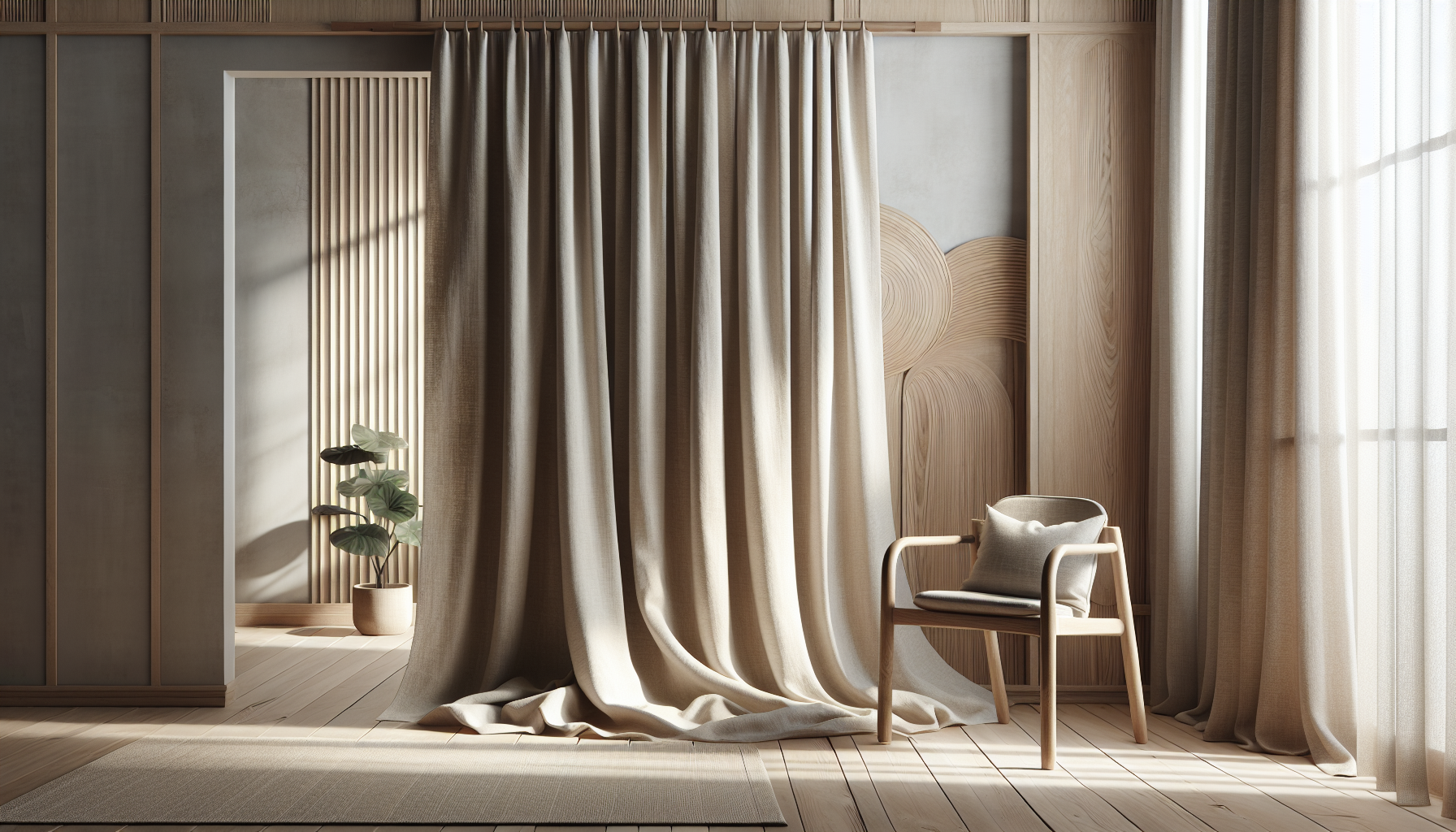Are you considering updating your windows with new curtains and feeling torn between linen and cotton? The choice of fabric can significantly impact your home’s aesthetic, especially in a Japandi-style setting.
Understanding Japandi Style
Japandi combines Japanese minimalism with Scandinavian functionality, creating a harmonious balance of simplicity and elegance. When it comes to interior décor, every piece, including curtains, must contribute to this overall vibe. The textures, colors, and materials you choose play a pivotal role in achieving that perfect Japandi look.
The Role of Curtains in Japandi Interiors
Curtains are not just functional; they can elevate your decor. In Japandi spaces, the right curtains can enhance the natural light while providing privacy, warmth, and texture. Both linen and cotton can serve this purpose, but they each bring their unique qualities to the table.
The Allure of Linen Curtains
When you think of linen, what often comes to mind is a soft, airy fabric with a relaxed elegance. Linen has been used for centuries, and its enduring popularity is a testament to its qualities.
Advantages of Linen Curtains
-
Natural Texture
Linen has a beautiful, slightly textured appearance that adds depth to any space. Its relaxed look aligns perfectly with the Japandi aesthetic, emphasizing a connection to nature. -
Breathability and Draping
The breathability of linen allows it to hang elegantly, providing a gentle movement when there’s a breeze. This quality enhances the organic feel of your interior. -
Durability
One of the most appealing aspects of linen is its strength. With proper care, linen curtains can last for years, making them a worthy investment for your Japandi home. -
Eco-Friendly
Linen is derived from flax plants, which require less water and pesticides compared to cotton. If sustainability is important to you, opting for linen could be a step in the right direction. -
Light Filtering
Linen has a natural ability to filter light softly, creating a warm ambience in your home without completely blocking daylight. This quality is perfect for creating serene, inviting spaces typical of Japandi design.
Disadvantages of Linen Curtains
While linen has its perks, it’s essential to consider the downsides as well.
-
Cost
Linen curtains can be more expensive than cotton. Depending on your budget, this might influence your decision. -
Wrinkles Easily
Linen is known for its tendency to wrinkle, which may not align with your preference for a neat appearance. -
Limited Color Options
While linen can come in various colors, the range is often more limited compared to cotton, which might be a drawback if you have a specific palette in mind.
The Comfort of Cotton Curtains
Cotton is one of the most widely used fabrics for curtains, and it’s not hard to see why. It’s versatile and can be found in numerous designs, patterns, and colors.
Advantages of Cotton Curtains
-
Affordability
Cotton curtains are typically more budget-friendly than linen. This factor can make a significant difference, especially if you’re looking to dress multiple windows. -
Wide Variety
The availability of cotton in various colors, prints, and textures allows you to explore more design possibilities, accommodating different tastes and styles. -
Easy Maintenance
Cotton curtains are generally machine washable and require less care than linen. For busy individuals, this can be a huge advantage. -
Less Wrinkling
While cotton can wrinkle, it tends to hold its shape better than linen. If neatness is a priority, this might be a significant factor for you. -
Light Control
Depending on the weave, cotton curtains can provide varying degrees of light control. This versatility allows you to choose the privacy level you desire.
Disadvantages of Cotton Curtains
Cotton isn’t without its downsides, and considering these can help you make a more informed decision.
-
Less Durable
While cotton is fairly durable, it may not hold up as well as linen over time, especially in high-traffic areas. -
Synthetic Options
Some cotton curtains are blended with synthetic fibers, which may detract from the organic feel you’re aiming for in a Japandi home. -
Less Texture
The smoothness of cotton may not convey the same natural warmth and texture as linen. This could make it challenging to achieve the cozy vibe characteristic of Japandi interiors.
Linen vs. Cotton: A Comparison Table
To make your decision-making easier, here’s a comparison of linen and cotton curtains directly:
| Attribute | Linen Curtains | Cotton Curtains |
|---|---|---|
| Cost | More expensive | Generally less expensive |
| Durability | Highly durable | Moderately durable |
| Texture | Natural, textured | Smoother, less texture |
| Maintenance | Requires gentle care | Easy to wash |
| Wrinkling | Prone to wrinkles | Less prone to wrinkling |
| Eco-Friendliness | More eco-friendly | Can be blended with synthetics |
| Light Filtering | Soft light filtering | Varying degrees of light control |
| Variety | Limited colors | Wide variety available |
Which Fabric Fits Your Needs?
Now that you have a better understanding of the advantages and disadvantages of both linen and cotton curtains, the next step is evaluating your specific needs and environment:
Consider Your Aesthetic Preferences
Are you drawn to the texture and organic quality of linen, or do you prefer the versatility and ease of maintenance that cotton offers? Your personal style plays a significant role in your choice.
Think About Your Budget
If you’re working with a limited budget, cotton might be the way to go. You can still find high-quality options that fit well within your financial constraints, allowing you to invest in other home décor pieces.
Evaluate Your Maintenance Routine
How much time and effort are you willing to put into maintaining your curtains? If you’re looking for something low-maintenance, cotton could be more suitable.
Assess Your Home Environment
Consider the room, its use, and the level of sun exposure. For example, if you’re dressing a living room that gets a lot of light, the soft filtering qualities of linen may be beneficial. However, if you’re in a bathroom or kitchen, more robust cotton might be more appropriate.
Final Thoughts: Making The Right Choice
In a Japandi home, both linen and cotton curtains have their unique benefits and challenges.
Emphasizing Natural Elements
To harmonize with the Japandi concept, the focus should be on natural materials and simplicity. Linen, with its earthy, organic feel, can significantly contribute to this aesthetic while maintaining a casual elegance.
Balancing Practicality and Style
Ultimately, your decision should reflect a balance between practicality and your style preferences. Perhaps you even consider using both; for instance, opt for linen curtains in the main living space for their serene appearance, while choosing cotton in utility areas for durability and ease of care.
Curate Your Space Intentionally
Regardless of the material you choose, the key is to curate your space with intention. Think about how your curtains will complement the other elements of your decor—furniture, wall colors, and overall theme. By doing so, you will create a cohesive look that embodies the spirit of Japandi style.
In summary, whether you lean towards the natural elegance of linen curtains or the practicality of cotton, it’s all about finding what resonates with you and suits your home’s needs. Take your time in making this decision, and remember that whatever you choose, it should reflect your personality and lifestyle while enhancing the beauty of your Japandi space.

